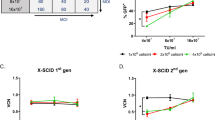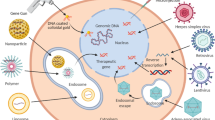Abstract
Pre-clinical studies indicate that efficient retrovirus-mediated gene transfer into hematopoietic stem cells and progenitor cells can be achieved by co-localizing retroviral particles and target cells on specific adhesion domains of fibronectin. In this pilot study, we used this technique to transfer the human multidrug resistance 1 gene into stem and progenitor cells of patients with germ cell tumors undergoing autologous transplantation. There was efficient gene transfer into stem and progenitor cells in the presence of recombinant fibronectin fragment CH-296. The infusion of these cells was associated with no harmful effects and led to prompt hematopoietic recovery. There was in vivo vector expression, but it may have been limited by the high rate of aberrant splicing of the multidrug resistance 1 gene in the vector. Gene marking has persisted more than a year at levels higher than previously reported in humans.
This is a preview of subscription content, access via your institution
Access options
Subscribe to this journal
Receive 12 print issues and online access
$209.00 per year
only $17.42 per issue
Buy this article
- Purchase on Springer Link
- Instant access to full article PDF
Prices may be subject to local taxes which are calculated during checkout



Similar content being viewed by others
References
Kohn, D.B. et al. A clinical trial of retroviral-mediated transfer of a rev-responsive element decoy gene into CD34(+) cells from the bone marrow of human immunodeficiency virus-1-infected children. Blood 94, 368 –371 (1999).
Kohn, D.B. et al. T lymphocytes with a normal ADA gene accumulate after transplantation of transduced autologous umbilical cord blood CD34+ cells in ADA-deficient SCID neonates. Nature Med. 4, 775– 780 (1998).
Dunbar, C. & Kohn, D. Retroviral mediated transfer of the cDNA for human glucocerebrosidase into hematopoietic stem cells of patients with Gaucher disease. A phase I study. Hum. Gene Ther.y 7, 231–253 (1996).
Brenner, M.K. et al. Gene marking to determine whether autologous marrow infusion restores long-term haemopoiesis in cancer patients. Lancet 342, 1134–1137 (1993).
Hesdorffer, C. et al. Phase I trial of retroviral-mediated transfer of the human MDR1 gene as marrow chemoprotection in patients undergoing high-dose chemotherapy and autologous stem-cell transplantation. J. Clin. Oncol. 16, 165–172 (1998).
Hanania, E.G. et al. Results of MDR-1 vector modification trial indicate that granulocyte/macrophage colony-forming unit cells do not contribute to posttransplant hematopoietic recovery following intensive systemic therapy. Proc. Natl. Acad. Sci .USA 93, 15346–15351 (1996).
Kohn, D. B. et al. Engraftment of gene-modified umbilical cord blood cells in neonates with adenosine deaminase deficiency. Nature Med. 1, 1017–1023 (1995).
Dunbar, C.E. et al. Retrovirally marked CD34-enriched peripheral blood and bone marrow cells contribute to long-term engraftment after autologous transplantation . Blood 85, 3048–3057 (1995).
Emmons, R.V.B. Retroviral gene transduction of adult peripheral blood or marrow-derived CD34+ cells for six hours without growth factors or on autologous stroma does not improve marking efficiency assessed in vivo. Blood 89, 4040–4046 (1997).
Orlic, D. et al. Identification of human and mouse hematopoietic stem cell populations expressing high levels of mRNA encoding retrovirus receptors. Blood 91, 3247–3254 ( 1998).
Dunbar, C.E. et al. Improved retroviral gene transfer into murine and Rhesus peripheral blood or bone marrow repopulating cells primed in vivo with stem cell factor and granulocyte colony-stimulating factor. Proc. Natl. Acad. Sci. USA 93, 11871–11876 (1996).
MacNeill, E.C. et al. Simultaneous infection with retroviruses pseudotyped with different envelope proteins bypasses viral receptor interference associated with colocalization of gp70 and target cells on fibronectin CH-296. J. Virol. 73, 3960–3967 (1999).
Traycoff, C.M. et al. The 30/35 kDa chymotryptic fragment of fibronectin enhances retroviral-mediated gene transfer in purified chronic myelogenous leukemia bone marrow progenitors. Leukemia 11, 159 –167 (1997).
Moore, K.A. et al. Stromal support enhances cell-free retroviral vector transduction of human bone marrow long-term culture-initiating cells. Blood 79, 1393–1399 ( 1992).
Moritz, T., Patel, V.P. & Williams, D.A. Bone marrow extracellular matrix molecules improve gene transfer into human hematopoietic cells via retroviral vectors. J. Clin. Invest. 93, 1451–1457 (1994).
Baum, C. et al. Novel retroviral vectors for efficient expression of the multidrug resistance (mdr-1) gene in early hematopoietic cells. J. Virol. 69, 7541–7547 ( 1995).
Thomsen, S. et al. Lack of functional Pit-1 and Pit-2 expression on hematopoietic stem cell lines. Acta Haematol. 99, 148– 155 (1998).
Kotani, H. et al. Improved methods of retroviral transduction and production for gene therapy. Hum. Gene Ther. 5, 19– 28(1994)
Hanenberg, H. et al. Colocalization of retrovirus and target cells on specific fibronectin fragments increases genetic transduction of mammalian cells. Nature Med. 2, 876–882 ( 1996).
Kiem, H.P. et al. Improved gene transfer into baboon marrow repopulating cells using recombinant human fibronectin fragment CH-296 in combination with interleukin-6, stem cell factor, FLT-3 ligand, and megakaryocyte growth and development factor . Blood 92, 1878–1886 (1998).
Cooper, M.A. & Einhorn, L.H. Maintenance chemotherapy with daily oral VP-16 following salvage therapy in patients with germ cell tumors . J. Clin. Oncol. 13, 1167– 1169 (1995).
Ueda, K. et al. Expression of a full-length cDNA for the human ‘MDR1’ gene confers resistance to colchicine, doxorubicin and vinblastine. Proc. Natl. Acad. Sci. USA 84, 3004– 3008 (1987).
Ward, M. et al. Transfer and expression of the human multiple drug resistance gene in human CD34+ cells. Blood 84, 1408 –1414 (1994).
Fan, Y. et al. Detection of germ cell tumor cells in apheresis products using polymerase chain reaction. Clin. Cancer Res. 4, 93–98 (1998).
Chou, P.M. et al. Differential expression of p53, c-kit, and CD34 in prepubertal and postpubertal testicular germ cell tumors. Cancer 79, 2430–2434 (1997).
Galipeau, J. et al. A bicistronic retroviral vector for protecting hematopoietic cells against antifolates and P-glycoprotein effluxed drugs. Hum. Gene Ther. 8, 1773–1783 (1997).
Sorrentino, B.P. et al. Expression of retroviral vectors containing the human multidrug resistance 1 cDNA in hematopoietic cells of transplanted mice. Blood 86, 491–501 ( 1995).
Ward, M. et al. Retroviral transfer and expression of the human multiple drug resistance (MDR) gene in peripheral blood progenitor cells. Clin. Cancer Res. 2, 873–876 ( 1996).
Moscow, J.A. et al. Engraftment of MDR1 and NeoR gene-transduced hematopoietic cells after breast cancer chemotherapy. Blood 94, 52–61 (1999).
Cowan K.H. et al. Paclitaxel chemotherapy after autologous stem-cell transplantation and engraftment of hematopoietic cells transduced with a retrovirus containing the multidrug resistance complementary DNA (MDR1) in metastatic breast cancer patients Clin. Cancer Res. 5, 1619– 1628 (1999).
Cornetta, K. Safety aspects of human gene therapy. Br. J. Haematol. 80, 421–426 (1992).
Hanenberg, H. et al. Optimization of fibronectin-assisted retroviral gene transfer into human CD34+ hematopoietic cells. Hum. Gene Ther. 82, 2193–2206 (1997).
Hennemann, B. et al. Optimization of retroviral-mediated gene transfer to human NOD/SCID mouse repopulating cord blood cells through a systematic analysis of protocol variables. Exp. Hematol. 27, 817–825 (1999).
Stewart A.K. et al. Engraftment of gene-marked hematopoietic progenitors in myeloma patients after transplant of autologous long-term marrow cultures. Hum. Gene Ther. 10, 1953–1964 (1999).
Dao, M.A. et al. Adhesion to fibronectin maintains regenerative capacity during ex vivo culture and transduction of human hematopoietic stem and progenitor cells. Blood 92, 4612–4621 (1998).
Cavazzana-Calvo, M. et al. Correction of SCID-X1 disease phenotype following γ c gene transfer by a retroviral vector into CD34+ cells in two children. Blood (suppl. 1) 94, 367a ( 1999).
Tisdale, J.F. et al. Ex vivo expansion of genetically marked rhesus peripheral blood progenitor cells results in diminished long-term repopulating ability . Blood 92, 1131–1141 (1998).
Goerner, M. et al. The use of granulocyte colony-stimulating factor during retroviral transduction on fibronectin fagment CH-296 enhances gene transfer into hematopoietic repopulating cells in dogs. Blood 94, 2287 –2292 (1999).
Bunting, K.D. et al. Transduction of murine bone marrow cells with an MDR1 vector enables ex vivo stem cell expansion, but these expanded grafts cause a myeloproliferative syndrome in transplanted mice. Blood 92, 2269–2279 (1998).
Richardson, C. & Bank, A. Preselection of transduced murine hematopoietic stem cells populations leads to increased long-term stability and expression of human multiple drug resistance gene. Blood 86, 2579–2589 (1995).
Sorrentino, B. et al. Selection of drug-resistant bone marrow cells in vivo after retroviral transfer of human MDR1. Science 257, 99–103 (1992).
Cornetta, K. et al. Infection of human cells with murine amphotropic replication-competent retroviruses. Hum. Gene Ther. 4, 579– 588 (1993).
Morgan, R.A., Cornetta, K. & Anderson, W.F. Application of polymerase chain reaction in retroviral-mediated gene transfer and the analysis of gene-marked human TIL cells. Hum. Gene Ther. 1, 136–149 (1990).
Acknowledgements
We thank the patients and their families for their contributions to this study. We thank the Indiana University General Clinical Research Center, Stem Cell Laboratory (V. Graves and J. Baily), Apheresis, and BMT unit staff for excellent technical and clinical care. We thank S. Harker from the General Clinical Research Center nursing staff for her contribution to this study. We thank the members of the Gene Therapy Working Group for their contribution (L. Rubin, J. Croop, M. Dinauer, S. Richeson, L. Reeves, J. Good and S. Holbrook). This work was supported by the National Centers for Research Resources (National Institutes of Health M01 RR00750) (R.A.) and an American Cancer Society grant CRTG-97-042-EDT (R.A.). The National Gene Vector Laboratory (U42 RR/1148 and CA11148) produced the clinical-grade vector. Additional support was provided by the Indiana University Vector Core and the Stem Cell Laboratory Core (2 P30 DK49218 and P01 HL 53586) (K.C. and R.A.). Takara Shuzo (Otsu, Japan) has provided the Gene Therapy Working Group with an unrestricted grant to help conduct clinical gene therapy trials at our center. A.B. has an equity interest in Genetix Pharmaceuticals, which provided the vector-packaging cell line (A12M1) to the National Gene Vector Laboratory for this study. D.A.W. may receive royalties based on ‘milestones’ set forth in a licensing agreement between Takara Shuzo and Indiana University.
Author information
Authors and Affiliations
Rights and permissions
About this article
Cite this article
Abonour, R., Williams, D., Einhorn, L. et al. Efficient retrovirus-mediated transfer of the multidrug resistance 1 gene into autologous human long-term repopulating hematopoietic stem cells . Nat Med 6, 652–658 (2000). https://doi.org/10.1038/76225
Received:
Accepted:
Issue Date:
DOI: https://doi.org/10.1038/76225
This article is cited by
-
Amino acid modified [70] fullerene derivatives with high radical scavenging activity as promising bodyguards for chemotherapy protection
Scientific Reports (2018)
-
Chemoprotection of murine hematopoietic cells by combined gene transfer of cytidine deaminase (CDD) and multidrug resistance 1 gene (MDR1)
Journal of Experimental & Clinical Cancer Research (2015)
-
Chemoselection of Allogeneic HSC After Murine Neonatal Transplantation Without Myeloablation or Post-transplant Immunosuppression
Molecular Therapy (2012)
-
Optimal conditions for lentiviral transduction of engrafting human CD34+ cells
Gene Therapy (2011)



